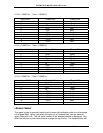
INTERFACE MODEL 9840 VER 6.0.2
>>Cal Check
Selecting this item will run a calibration check on the cell attached to Channel A or B.
The Model 9840 will measure the shunt value of the cell and compare it to the shunt
value that was recorded when the cell was last calibrated. The rated load or torque
and last calibration date for the cell are displayed followed by the currently measured
shunt value and the shunt value that was recorded when the cell was calibrated.
Note that the Model 9840 has a switch on the back panel that allows you to select
either a 30K shunt or a 60K shunt. Be sure that this switch is set correctly for the cell
that you are using.
Since this shunt check electronically applies approximately half the rated load or
torque, it is important that the cell is not loaded when this check is run. If you see the
“Cell Overloaded” message, remove any load or torque on the cell and try the check
again.
>>Cal by mV/volt (2-Point or 6-Point)
This item is used to calibrate a cell using the manufacturer’s milli-volt per volt
calibration factor (the second point of a two point calibration that automatically sets the
first point at zero) or a series of six milli-volt per volt points with corresponding masses
(usually listed on the load cell calibration certificate) or torques. Before you enter in
the desired information, another menu will ask you if you want to calibrate by milli-volt
per volt or 6 point milli-volt per volt. Pressing the arrow keys will allow you toggle
between mV/volt and 6 point mV/volt modes. You will then be asked for the channel,
the cell serial number, the current date, the calibration unit, the cell’s maximum rated
load or torque, and the desired excitation voltage (5.0 or 10.0 volts). If milli-volt per
volt calibration was selected, you are then prompted to enter the manufacturer’s milli-
volt value. If 6 point milli-volt per volt calibration was selected, you are prompted for
each mass or torque and milli-volt per volt value. A piece-wise linear interpolation is
then performed between adjacent points. One of these points should be zero mass
and zero milli-volts per volt. Enter each of these selections as prompted or press the
escape button at any time to return to the setup mode main menu without changing
the calibration. The cell should not be under load or torque when this calibration
method is used since a shunt value will be measured and recorded for later use with
“Cal Check” feature described above. The “No Masses Ready” or “No Torque Ready”
message is intended to remind you of this fact. This general sequence of prompts
and user responses also applies to the 5 point mass or torque calibration.
>>Cal by Masses or Torque (2-Point or 5-Point)
These items are used to calibrate a load or torque cell using known masses or
torques. The appropriate choice will be available depending on which cell type was
chosen at the beginning of calibration: a load cell will show Masses as an option and a
torque cell will show Torque as an option. Before you enter in the desired information,
another menu will ask if you want to calibrate by 2 Point or 5 Point. You will then be
asked for the channel, the cell serial number, the date, the calibration unit, the cell’s
maximum rated load or torque, and the desired excitation voltage (5.0 or 10.0 volts).
You are then prompted to enter the value of the first mass or torque. The “Mass 1
Ready?” or "Torque 1 Ready?" message will wait while you actually hang the mass or
MODEL 9840 PG 19 PUB. 2856-16


















